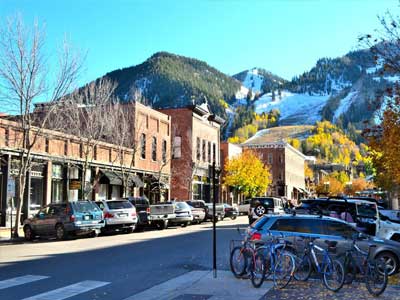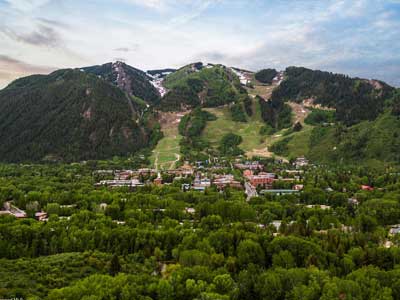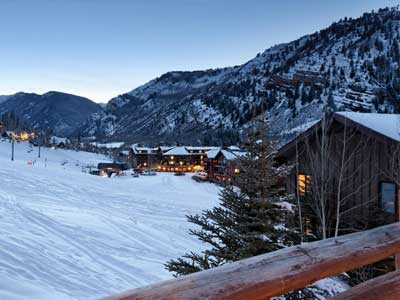Snowmass Village has been remade time and again—without much success—but a trio of owners believes the latest effort will transform the town into the destination it has always aspired to be.
BY KELLEY MCMILLAN MANLEY • 5280 TRAVELER 2019
Editor’s note: This article originally appeared in our November 2018 issue. This version was fact-checked and updated (where possible) with current information for the 2019 edition of 5280 Traveler.
At 13,305 feet, Mt. Daly dominates the skyline as you wind up Brush Creek Road toward Snowmass Village. The mountain’s smooth lines and signature gold stripe beckon visitors to the 51-year-old ski resort that lies just nine miles northwest of Aspen. Upon reaching the threshold of Snowmass’ base village, however, the view morphs from groves of aspen trees to stands of cranes and dramatic cathedrals of rebar rising out of half-built structures. Dirt, churned up by bulldozers, hangs heavy in the high-elevation air.
The sight of workers in steel-toe boots and the din of construction have become commonplace in the village over the past two years. But it isn’t the first time locals and visitors have watched a redevelopment plan spring from blueprints into real life near the intersection of Wood Road and Carriage Way. Since 1999, the ownership of Snowmass’ base village has changed hands five times; each time, the developer has put forth a different dream for what Snowmass Village should be.
When the Snowmass ski area opened in December 1967, its original builders envisioned an American version of the Arlberg, a region in Austria that features villages connected by lifts and ski runs. Upon Snowmass’ unveiling, the ski mountain was hailed as one of the best places to make turns in the United States, and from 1967 to 1999, there were several attempts to manufacture a base village area—which was mostly comprised of parking lots and administrative offices—to match the majesty of the adjacent slopes. Those efforts never materialized, largely because they were found to be economically unviable and attention was perhaps more focused on developing Snowmass Mall, a slopeside commercial hub about a half-mile uphill from the base.
The base village sat mostly untouched until 1999, when Aspen Skiing Company bought roughly 11 acres in the core of Snowmass Village. Two years later, SkiCo (as locals call it) partnered with Intrawest, which had developed Copper Mountain ski resort and River Run Village at Keystone Resort in the 1990s. A full-scale development project was chugging along when, in 2007, SkiCo and Intrawest sold the property to Related WestPac for $169 million. With this new asset in its portfolio, Related WestPac planned to invest millions into transforming Snowmass Village into one of the best ski resort towns on the planet.
Then came the Great Recession, and the project plunged into foreclosure. From 2009 to 2017, the entrance to Snowmass Village was little more than rebar with a faux façade slapped over it. The little hamlet became the land of unfulfilled obligations and unfinished plans. “People who had come here for many years to ski were tired of all the broken promises—the start, stop, start, stop—and it really did hurt our image,” says Snowmass Village Mayor Markey Butler. The developers’ divergent visions had muddied Snowmass Village’s identity and confused consumers. Was it a family ski area? A luxury resort? A cheaper, quieter alternative to Aspen?
For all of those reasons, Snowmass’ base village simply never caught on as a destination. At least—it hasn’t yet. In December 2016, SkiCo, along with private equity firm KSL Capital Partners and developer East West Partners, purchased Snowmass’ base village. The trio of owners plans to pour $600 million over the next seven or eight years into re-redefining the town. “Snowmass will realize its full potential as one of the best year-round, mountain resorts in North America,” SkiCo CEO Mike Kaplan said in a statement. His confidence is inspiring, but hard evidence that this partnership will succeed where so many others have failed remains elusive.
It’s a bright spring day, and Aspen Mountain is coated with a foot of new snow. At the base, the familiar whir of the Silver Queen Gondola hums in the background as it carries a line of high-fiving powderhounds up the hill. Nearby, satisfied skiers sip martinis at Ajax Tavern; fur-clad shoppers stroll from Ralph Lauren to Valentino; and, at night, a host of world-class eateries, such as Matsuhisa Aspen and Element 47, overflow with locals and tourists alike. Aspen Mountain has been drawing legions of devotees since the resort opened in 1946, and its energy is palpable. Unfortunately for Snowmass Village, the buzz of success hasn’t been contagious.
For years, the crux of Snowmass Village’s problem has been this: On any given day, 60 percent of skiers with Aspen Snowmass lift tickets, which grant access to four distinct mountains, are schussing on Snowmass’ slopes, but once the lifts stop spinning, they head elsewhere to eat, drink, and sleep. “There hasn’t been enough of a lodging product in Snowmass—and the adjunct food and beverage—to keep people here,” says Don Schuster, SkiCo’s senior vice president of hospitality. And, unlike Aspen, there’s never been a central gathering place for people to see and be seen—no charming downtown, no trendy restaurants and bars. “Snowmass has always needed a living room, or a place to go,” Schuster says. As a result, most days, Snowmass’ base village area feels like a deserted hinterland.
With that in mind, SkiCo, KSL, and East West Partners unveiled the first phase of their multiyear redevelopment of Snowmass’ base village in December with the openings of Lumin, a luxury condo building, and Limelight Hotel Snowmass, a 99-room, 11-residence complex. Snowmass’ base village’s owners expect the Limelight to function as the village’s shiny new centerpiece. With a five-story climbing wall, a kids’ room with games, live music during peak season, and a low-key restaurant and bar that spills out onto a patio overlooking the village, it seems poised to be the “living room” Schuster says Snowmass’ base village has so desperately needed.
The Limelight joins the 163-room Viceroy Snowmass, a nine-year-old hotel that will also anchor the re-imagined village. In November 2017, the Viceroy began implementing a $4 million face-lift; it opened a ski-in, ski-out bar at the start of this past season. The upgrades are strategic: The developers are counting on the one-two punch of the Viceroy and the Limelight to compel bodies off their sticks, onto bar stools, and then into hotel rooms. “The two hotels are critical,” says Andy Gunion, managing partner of East West’s Snowmass project. “It’s a key point in terms of creating vibrancy.”
Of course, one or two ritzy hotels cannot engender the vitality necessary for an entire village to thrive. That’s especially true when one considers that the town has a number of pesky design flaws, most notably its three commercial nodes: the base village, which sits at the bottom of the ski hill; Snowmass Mall, a dated commercial center just uphill from the base village filled with shops, bars, and restaurants; and Snowmass Center, a strip-mall-like plaza popular with locals across Brush Creek Road from the base.
Having three separate hubs of activity means the town lacks a true center. “You can keep putting Band-Aids on things, but if the root of the disease isn’t figured out, then it’s never going to change,” says Jenny Lynn Hayes, who co-owned the Sweet Life restaurant and ice cream shop in Snowmass’ base village from 2008 to 2011. While her outpost in Telluride was doing comparatively well, she was forced to close the Snowmass location after losing hundreds of thousands of dollars, which she attributes to the recession as well as to Snowmass Village’s design defects. The base village simply did not generate enough traffic to sustain her business. “I’m not sure if Snowmass has ever figured out the root of the problem,” she says. “I think it’s the disjointedness. But how do you fix that?”
Gangs of mountain bikers heading to Snowmass’ bike park whiz by the East West sales office in the village. Andy Gunion, a laid-back fortysomething who probably wishes he were on two knobby tires instead of at work, is detailing the fancy 3D model of the base village. Maybe he’s just a good salesman, but Gunion appears to be genuinely optimistic about what’s happening in Snowmass Village.
That positivity could stem from the fact that he’s moderated his own hopes for Snowmass’ future. “Our expectation is that this is going to be an amazing place for families to vacation,” Gunion says. “If you have an expectation that this place is going to become Aspen, then it’s not going to be met. We’re something much different than Aspen.” In fact, Gunion and his team spent time visiting Vail and Beaver Creek ski resorts, where they found inspiration for a vision of Snowmass’ new base village.
First, to make the area feel less cookie-cutter and more like it evolved organically over time, East West has hired several architectural and interior design firms to design the village’s buildings, each bringing a different aesthetic. Then, from Beaver Creek, which East West helped develop, Gunion and Co. plucked the idea of an ice rink and a fire-pit-bedecked events plaza to anchor the village. The Limelight’s patio will melt—seamlessly, Gunion hopes—into those shared spaces. A community center, slated to be fully open for winter 2019-’20, will sit on the edge of the plaza and will likely host film premieres, lectures, and concerts as well as a game room, pop-up restaurants, and a small permanent exhibit of mastodon fossils from the nearby Ice Age Discovery Center. Rounding out the base area will be at least three new restaurants, about five new retail spaces, and, once the project is completed, approximately 250 new upscale residences.
That may sound like a bushel of condos for a place that’s struggling to attract overnight visitors. But that number stands in stark contrast to the thousand or more smaller, less ritzy condos other resorts have, at times, delivered to their markets. It’s a calculated move by East West, which says it believes prospective buyers want larger, upscale properties that live more like single-family homes than the tiny hotel-room-like condos seen at resorts like, say, Copper Mountain. Gunion emphasizes that one of East West’s primary jobs is to sell condos, but he acknowledges that some of the buyers are interested in renting their homes post purchase. “We have seen a trend of nicer, luxury properties renting with more frequency,” Gunion says. “That didn’t drive the design of these properties, but it was part of the equation.” Which makes sense because short-term rentals could result in higher occupancy rates, something Snowmass Village needs.
What Gunion’s 3D model doesn’t show is how Snowmass’ base village developers plan to remedy the problem of the town’s existing infrastructure. But there has been recent movement there, too. In 2016, Eastwood Snowmass Investors purchased Snowmass Center, and in summer 2018 the Romero Group bought 80,000 square feet of commercial space in the Snowmass Mall. There have been discussions in the town council about linking the base village to Snowmass Center via a bridge or gondola. And, in the interest of creating energy resort-wide, East West Partners, Eastwood Snowmass Investors, and the Romero Group met last September to talk about their respective commercial hubs. No formal strategy to work together has been established, though, and there seems to be little urgency to do so.
The first few notes of “Two Princes” float across the alpine meadow next to the Snowmass Mall. A couple hundred people—young families playing cornhole, thirtysomethings dancing, retirees kicking back in lounge chairs and sipping cocktails—have gathered in the late-afternoon sun to catch a free show by the ’90s rock band Spin Doctors.
The concerts held on Thursday and Saturday evenings in the summer have been an ongoing event for years, but finding ways to attract more year-round guests is on the minds of everyone involved in Snowmass Village’s rebirth. In June 2018, SkiCo debuted the Lost Forest, a $10 million-plus adventure center on the mountain featuring a zip line, a mountain coaster, a ropes course, a climbing wall, and new bike trails. And Snowmass Tourism unveils several new events each summer; in June, it was the village’s first Ride the Rockies cycling showcase. The efforts appear to be working: Summer occupancy rates increased 98 percent from 2012 to 2018.
Snowmass Village has another reason to be hopeful it will see more visitors. This past ski season, it became part of the Ikon Pass, which includes five to seven days of skiing at Aspen Snowmass in addition to unlimited skiing at places like Copper Mountain, Winter Park Resort, and Eldora Mountain, making it an appealing option for Denverites and a formidable rival to the Epic Pass.
Of course, whether the first phase of the project will bring success remains to be seen, and there are those with serious doubts. “By and large, these ski resort villages have failed to meet the aspirations of the developers,” says Ford Frick, a Denver-based specialist in resort development economics. “The failure has been in creating active, vital, interesting, financially successful places. They have not achieved that at the level they hoped.”
Still, there may be reasons for optimism. Condo sales in the area were up about 50 percent from 2017 to 2018. Nine of the Limelight’s 11 residences and all three of the Lumin’s units had been claimed as of mid-April. The Limelight hotel, which opened in December, saw 71 percent occupancy in its first ski season. Adding to the village’s growing accommodations list is One Snowmass, a luxury 11-residence development set to open in September. Maybe most important, though, there’s a revived level of sanguinity in the community. “It’s really an exciting and dynamic time for Snowmass,” says Dwayne Romero, CEO and president of the Romero Group. “This is not Vail adding another hotel tower. This is Snowmass redefining itself.”






















0 Comments